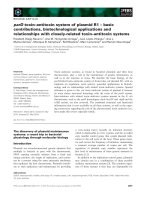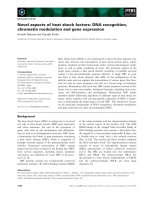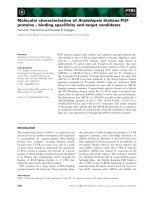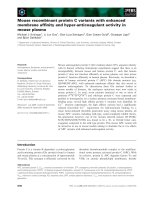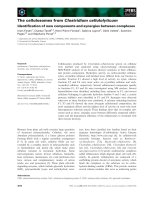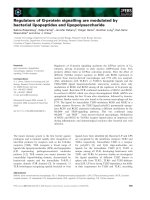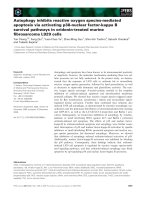báo cáo khoa học: "Sentinel lymph node biopsy using dye alone method is reliable and accurate even after neo-adjuvant chemotherapy in locally advanced breast cancer - a prospective study" pps
Bạn đang xem bản rút gọn của tài liệu. Xem và tải ngay bản đầy đủ của tài liệu tại đây (246.84 KB, 7 trang )
RESEARCH Open Access
Sentinel lymph node biopsy using dye alone
method is reliable and accurate even after
neo-adjuvant chemotherapy in locally advanced
breast cancer - a prospective study
Chintamani
1,2*
, Megha Tandon
1,2
, Ashwani Mishra
2,3
, Usha Agarwal
2,3
, Sunita Saxena
2,3
Abstract
Background: Sentinel lymph node biopsy (SLNB) is now considered a standard of care in early breast cancers with
N0 axillae; however, its role in locally advanced breast cancer (LABC) after neo -adjuvant chemotherapy (NACT) is
still being debated. The present study assessed the feasibility, efficacy and accuracy of sentinel lymph node biopsy
(SLNB) using “dye alone” (methylene blue) method in patients with LABC following NACT.
Materials and methods: Thirty, biopsy proven cases of LABC that had received three cycles of neo-adjuvant
chemotherapy (cyclophosphamide, adriamycin, 5-fluorouracil) were subjected to SLNB (using methylene blue dye)
followed by complete axillary lymph node dissection (levels I-III). The sentinel node(s) was/were and the axilla were
individually assessed histologically. The SLN accuracy parameters were calculated employing standard definitions.
The SLN identification rate in the present study was 100%. The sensitivity of SLNB was 86.6% while the accuracy
was 93.3%, which were comparable with other studies done using dual lymphatic mapping method. The SLN was
found at level I in all cases and no untoward reaction to methylene blue dye was observed.
Conclusions: This study confirms that SLNB using methylene blue dye as a sole mapping agent is reasonably safe
and almost as accurate as dual agent mapping method. It is likely that in the near future, SLNB may become the
standard of care and provide a less morbid alternative to routine axillary lymph node dissection even in patients
with LABC that have received NACT.
Introduction
Breast cancer is the most common site specific cancer in
women and represents 20% of all female malignancies.
In developing countries like India, 25-30% patients still
present with locally advanced breast cancers (LABC).
The current treatment guidelines for LABC focus upon
multimodality approach i.e. neo-adjuvant chemotherapy
(NACT)followedbysurgeryandadjuvanttherapiesin
the form of chemotherapy, radiotherapy, hormone ther-
apy etc. The well known advantages of NACT include,
down staging and do wnsizing of the tumo r to make it
amenable to brea st conservation surgery, as well as
serving as an in-vivo test of sensitivity to the chemother-
apy regimen used [1-3].
The histological status of axillary lymph nodes is one
of the most important prognostic factors in patients
with breast carcinoma and remains so, even after NACT
[1,2]. NACT, initially introduced to downstage LABC to
facilitate optimum surgery, results in an improved dis-
ease free survival and overall survival, which is compar-
able with the effects of adjuvant chemotherapy [4-7].
More recently, the indications for NACT have also been
extended to selected patients with an early staged dis-
ease to allow breast conserving surgery [8,9]. Another
potential advantage of NACT is the opportunity to
observe chemosenstivity in vivo,providingprognostic
information [10].
Whether sentinel lymph node biopsy (SLNB) is feasible
and accurate following N ACT is of significance, since
* Correspondence:
1
Department of Surgery, Vardhman Mahavir Medical College, Safdarjang
Hospital, New Delhi, 110023, India
Full list of author information is available at the end of the article
Chintamani et al. World Journal of Surgical Oncology 2011, 9:19
/>WORLD JOURNAL OF
SURGICAL ONCOLOGY
© 2011 Chintamani et al; licensee BioMed Central Ltd. This is an Open Access article distrib uted under the terms of the Creative
Commons Attribution License (http://cre ativecommons.org/lic enses/by/2.0), which permits unrestricted use, distribution, and
reproduction in any medium, provided the original work is properly cited.
axillary status gets down staged to N0 in considerable pro-
portion of patients after NACT (30-40%). Demonstrating
the accuracy of SLNB in this setting can help a proportion
of initially node positive patients that have been down
staged to N0 by avoiding the morbidity of routine axillary
lymph node dissection. The aim of this study was to deter-
mine the accurac y of SLNB foll owing NACT fo r LABC
using methylene blue dye alone.
Methods
The study was conducted in the Department of Surgery,
Vardhman Mahavir Medical College Safdarjang Hospital
in collaboration with Indian Council of Medical
Research, New Delh i, over a period of 1 year (from Dec
2008 to Jan 2009) after obtaining clearance from the
“Institutional review Board” and the “Ethical Commit-
tee” of Safdarjang Hospital New Delhi India.
Patients
Thirty fine needle aspiration cytology (FNAC) confirmed
cases of LABC (i.e. Stage IIb and stage III) were evalu-
ated after taking informed consent for enrolment in the
study. Ultrasonography (USG) and Magnetic resonance
imaging (MRI) of both breasts were done for accurate
measurement of the basal tumor size in order to stage
the disease accurately. A core needle biopsy was routi-
nely performed for baseline tumor marker status and
assessing the grade. The FNAC was not used for the
nodal metastases in the study. The patients were then
subjected to blood and radiological investigations
including an echocardiogram before initiation of neo-
adjuvant chemotherapy (NACT)that was administered
in standard doses at three weekly intervals [Cyclopho-
sphamide 500 mg/m
2
, Adriamycin 50 mg/m
2
(methotrex-
ate in cardiotoxic patients) and 5-FU 500 mg/m
2
]. All
cases were re-assessed clinically and with ultrasonogra-
phy and MRI of the breast (using RECIST criteria) for
response assessment after each cycle.
After 3 weeks o f the last cycle of NACT, the patients
were taken up for surgery i.e. modified radical mastect-
omy (MRM) with a standardized technique by the same
surgical team. Intra-operatively peri-tumoral injections of
2-3 ml of methylene blue dye were g iven followed by
breast massage for five minutes before the patient was
being draped and prepared for surgery. The sentinel
node/s (blue node/s) was mapped and isolated after rais-
ing the flaps (the average time taken for the dissection of
sentinel node was 10 minutes after i njection of the dye ).
Only nodes that were stained blue were considered as
sentinel i.e. even an enlarged or firm axillary node which
did not stain was not considered as sentinel. The average
number of sentinel nodes r emoved ranged from one to
four. The sentinel lymph node/s was/were sent in a sepa-
rate container and was/were assessed for the presence of
metastatic deposits and compared with the rest of the
axillary lymph nodes. As a part of the modified radical
mastectomy complete (level-I to level-III) axillary dissec-
tion was subsequently performed and the axillary lymph
nodes were sent for histopathological evaluation. In all
patients, a minimum of ten dissected lymph nodes were
considered as optimum axillary dissection.
Statistical analysis
Thirty patients of locally advanced breast carcinoma
were studied using descriptive statistics. The Mc
Nemar’s Chi square test and paired T test were used to
determine association between two variables. P value
less than or equal to 0.05 was taken as significant.
The values of the diagnostic parameters related to
techniques of SLNB were estimated in terms of sensitiv-
ity, specificity, positive predictive value, negative predic-
tive value, false negative rate and accuracy on the basis
of distribution of 30 cases into four categories of SLN
and axilla expression patterns.
Data analysis was performed by SPSS version 11.5.
Results
All 30 cases were of locally advanced carcinoma (i.e.
stage IIb and stage III). The age of the patients ranged
from 32-85 years with a mean age of 47.3 years and a
standard deviation of 10.98 years (Table 1). Majority of
the patients were post-menopausal (20 out of 30
patients i.e. 66.6%).
The distribution of tumor size before and after NACT
is shown in Table 2.
Using the paired t-test for significance, with 95% con-
fidence limits, (p < 0.001) the difference in the pre and
post neo-adjuvant chemotherapy tumor size was found
to be statistically significant.
56.70% of the patients in our study had clinically N2
disease (fixed ipsilateral axillary nodes), which was in
direct correlation with the large tumor size and
advanced stage of the disease. However none of the
patients had N0 or N3 axilla. After NACT most of the
patients were down staged with respect t o their axillary
lymph node status, with about half (50%) of them hav-
ing no clinical/sonological/MR I) evidence of lympha-
denopathy following NACT (Table 3).
Table 1 Group wise age distribution
Age (years) No. of patients Percentage
31-40 10 33.3%
41-50 12 40%
51-60 5 16.6%
61-70 3 10%
71-80 00%
81-90 1 3.33%
Chintamani et al. World Journal of Surgical Oncology 2011, 9:19
/>Page 2 of 7
Outof14patientsthatwereN1beforeNACT,9
(64.31%) were dow n staged to N0, while in 5(35.70%)
patients axillary status remained at N1. Out of total 16
patients that were N2 before NACT, 6(37.4%) were down
staged to N0. 5(31.3%) were down staged to N1, while in
5 (31.3%) patients there was no change in axillary status.
Using the ch i square test (p = 0.049), the diffe rence in
pre and post chemotherapy lymph node status was
found to be statistically significant.
Relationship of sentinel lymph node biopsy and axil-
lary status is summarized in the Tables 4 & 5
In 13 patients (n = 30) the SLN and the axilla were
both positive for the disease while in 2 patients (6.6%),
the SLN was negative while the axilla was positive (indi-
cating that the SLNB c ould not accurately predict the
axillary status). In 15 patients (50%, n = 30) both the
SLNandtheaxillawerenegativeandtheSLNBcould
accurately predict the status of the axilla.
In all patients sentinel lymph node/s was at level I
(lateral to Pectoralis minor)
Following parameters were calcula ted by applying
basic descriptive statistical methods:
Sensitivity of SLN = True positives/(true positives + false
negatives)
Was found to be = 86.67%
False negative rate = False negatives/(false negatives
+true positives)
Was found to be = 13.33%
Negative predictive value = True negative/(true negative +
false negative)
Was found to be = 88.23%
Accuracy = True positive + True negative/No. of
patients with successfully identified SLN
Was found to be = 93.30%
Sentinel lymph node accuracy parameters were calcu-
lated according to standard definitions, used in various
studies on sentinel lymph node/s (SLN) and they were
as follows:
• The Identifi cation Rate was defined as the number
of patients who underwent a successful SLN biopsy
divided by total number of patients in whom a SLN
biopsy was attempted. The identification rate in
the present study was 100% i.e. SLN could be identi-
fied in all thirty patients included in the study.
• The results from each successfully identified SLN
were categorized as true positives, true negatives, or
false negatives, taking the outcome of the complete
ALND as “reference standard”.
• A true negative SLN was defined in this study as a
negative SLN and a negative a xilla after ALND. The
true neg atives S LN in the present study were 15(50%) .
• A false negative SLN was def ined as negative SLN
with positive lymph nodes in ALND. There were 2
falsenegativecasesin the present study, out of a
total of 15 cases that had a positive axilla after
ALND. Of the two “false negative cases”,onewas
a “non responder” that was N2 (both p re and
post NACT) and the other was a responder (pre
NACT-N2 and post NACT-N1) i.e. Both false
negative cases were not N0 after three cycles of
NACT. 50% case s i.e. 15/30 cases in our study
were down staged from N1 or N2 to N0.
• A true positive SLN was defined as a positive SLN
with or without a positiv e axilla and in this study 13
cases were true positives.
Based on these definitions, there were no false posi-
tive cases in this study.
Accuracy was computed as the sum of all true posi-
tives and true negatives, divided by the to tal number of
Table 2 Pre NACT vs. Post NACT tumor Size
Mean N Std. Deviation
Pre NACT 6.31 30 2.4
Tumor Post NACT 3.44 30 1.9
Table 3 Lymph Node status before and after NACT Cross tabulation
Post NACT lymph nodes Total
N0 N1 N2
N1 Count 95014
% within Pre NACT lymph node 64.3% 35.7% 0 100%
Pre NACT lymph nodes N2 Count 65516
% within Pre NACT lymph node 37.4% 31.3% 31.3% 100%
Total Count 15 10 5 30
% within Pre NACT lymph node 50% 33.3% 16.7% 100%
Chintamani et al. World Journal of Surgical Oncology 2011, 9:19
/>Page 3 of 7
patients with a successfully identified SLN. Accuracy in
this study was 93.31%.
Discussion
The histological status of axillary lymph nodes is one of
the most important prognostic factors in patients with
breast carcinoma and remains so, even afte r NACT
[1,2]. NACT, initially introduced to downstage LABC to
facilitate optimum surgery, also results in an improved
disease free survival and overall survival, which is com-
parable with the effects of adjuvant chemotherapy [4-7].
More recently, the indications for NACT have also been
extended to selected patients with an early staged dis-
ease to allow breast conserving surgery [8,9]. Another
potential advantage of NACT is the opportunity to
observe chemosenstivity in vivo, providing vital prognos-
tic information [10].
Following NACT, traditionally ALND is performed as a
part of optimum breast surgery. This however is asso-
ciated with considerable morbidity [11,12]. A less aggres-
sive approach is therefore sought for, making SLNB after
NACT an attractive strategy as the axilla is downstaged
to N0 in a number of patients (20-40%) [8,13]. In concor-
dance with the established data, the nodal down staging
in the present study was about 50% (in the present study,
9 out of14 N1 and 6 o f 16 N2 patients were down staged
to N0 i.e. 15/30 patients). Thus considerable number of
patients could be spared the morbidity of ALND, once
the SLNB gets established as a standard of care in
patients with LABC after NACT.
Theoretically, NACT could have several negative
effects on the accuracy of the SLN biopsy. Firstly, both
primary tumor and metastatic lymph nodes respond by
yielding reactive changes like fibrosis affecting the lym-
phatic drainage patterns. Secondly, chemotherapy can
induce an uneven tumor response in axilla. These effects
are likely to result in decreased SLNB accuracy after
NACT. It has been observed in various studies (Table 6)
that there could be a reduction in the identification
rates without a significant drop in the predictive value
of SLNB even after NACT [14-18]. The accuracy and
false negative rates of sentinel lymph node biopsy after
NACT were found to be comparable with those of other
multicenter trials of SNB (without NACT) and the pre-
sent study also highlights the same [14-18]. The false
negative rates in the present study were 13.3%, favo rably
comparable with those of (7-13% ) in SNB studies before
NAC T, suggesting that the apprehension regarding skip
nodal metastasis could be over-rated and that the SLNB
remains almost equally reliable.
When comparing SLNB success rates amongst hetero-
geneous studies (i.e. between studies including patients
treated with NACT vs. those including patients that
have not received NACT), one must take into a ccount
the fact that false negative rates depend on the probabil-
ity of nodal involvement. Among the patients with
lower probability of nodal involvement, there is more
variation in the false negative rates because the sample
size would be smaller [18]. The various single institu-
tional studies evaluating SNB after NACT with their
results are summarized in Table 7.
The largest cohort study till date evaluating SNB after
NACT was NSABP B-27 multi-centric randomized trial
(N = 428), reported an identification rate, a false nega-
tive rate and accuracy of 85%, 11%, and 96% respectively
but the locally advanced breast cancers were not
included in th is study [14]. The overall success rates for
sentinel node identification w ere 84.4% which were
similar to results from other single institutional studies
[19-26]. This study also concluded that these rates are
comparable to those obtained from other multi-centric
studies evaluating SLNB and suggested that SLNB is fea-
sible and reliable following NACT. This was also
observed in the meta-analysis by Xing and colleagues
[15]. In the present study, an identification rate of 100%,
false negative rates of 13.30% and accuracy of 93.31%
were achieved. The rates do not differ substantially from
prio r multi-centric studies evaluating sentinel node suc-
cess rates without NACT, that have reported an identifi-
cation rate of 88-97% and false negative rates of 5-10%.
As summarized in Table 7, various single institutional
studies have examined th e efficacy of SLNB after NACT
in patients with operable as well as locally advanced
breast cancers and reported an identification rates
between 84 and 94% [19-21]. All these studies report a
higher identification rates when the dual mapping
Table 5 SLNB results by post-NACT axillary status (n =
30)
POST NACT AXILLARY STATUS
SLNB N0 = 15 N1 = 10 N2 = 5
+ve -ve +ve -ve +ve -ve
+ve334021
-ve091511
N0, N1, N2 is the pre-operative lymph node status, i.e. after NACT, while +
represents the histopathological report i.e. pN+/pN-
There were two “false negative cases”, one was a “non responder” that was
N2 (both pre and post NACT) and the other was a responder (pre NACT-N2
and post NACT-N1) i.e. both false negative cases cases were not N0 after
three cycles of NACT. 50% cases i.e. 15/30 cases in our study were down
staged from N1 or N2 to N0.
Table 4 Relationship of sentinel lymph node biopsy and
axillary status
Axilla(n = 30)
Sentinel lymph node Positive Negative
Positive 13 (43.3%) 0 (0%)
Negative 2 (6.6%) 15 (50%)
Chintamani et al. World Journal of Surgical Oncology 2011, 9:19
/>Page 4 of 7
method (i.e. radio-active colloid in combination with
blue dye) was used rather than any of the methods used
alone. The identification rate in the present study was
100% using the methylene blue dye alone and all the
lymph nodes were identified at level-I, highlighting that
even after NACT, lymphatic drainage remained more or
less predictable [19-25].
The false negative rates in these studies were quiet
variable (0-33%), leading to different conclusions about
the accuracy of the procedure in this setting. However
the small size of these studies can easily account for the
wide variability of the estimates. When o ne examines all
these studies after combining the outcomes, the false
negative rates would be 12.5%, comparable to our
experience and also to the rates seen in studies of S NB
before NACT. The false negative rates in our study
were 13.30%. Thereweretwo“false negative cases”,
one was a “non responder” that w as N2 (both pre
and post NACT) and the other was a responder (pre
NACT-N2 and post NACT-N1) i.e. both false nega-
tive cases were not N0 after three cycles of NACT.
Half the cases (50%) in the present study were down
staged from N1 or N2 to N0.
There are several limitations as well as strengths in the
present study. Limitations include smaller size and higher
variability in the age distribution of the cohort. Strengths
include the fa ct that the dat a was collected prospectively
and the same operating team ensured that there was a
uniform procedure for lymphatic mapping. There was
also a standardized procedure for pathological assess-
ment of the SLN and the axilla by a single team.
Conclusions
The present study confirms the observations of various
other studies in the literature that sentinel lymph node
biopsy is feasible and reliable even in locally advanced
carcinoma after NACT. The possibility of skip metastasis
is perhaps an exaggerated apprehension. There is a high
Table 6 Comparison of identification rates and false negative rates between NSABP-SNB after NACT trial B-27 and
three multicenter studies of SNB following breast cancer diagnosis [14-18]
Author Study Design No. of
patients
Type of lymphatic
mapping
Identification
rate %
False
negative
rate%
Mamounas
et al [14]
Multicenter SNB
after NACT
428 Blue dye Radiocolloid
Combination All techniques
78
89
88
85
14
05
09
11
Krag et al [16] Multicenter SNB before
systemic therapy
443 Radiocolloid 93 11
Tafra et al [17] Multicenter SNB before
systemic therapy
529 Combination of blue dye
and radiocolloid
87 13
Mc Masters
et al [18]
Multicenter SNB before
systemic therapy
806 Single agent (blue dye or radio colloid)
Combination All techniques
86
90
88
12
6
7
Table 7 Single institution series evaluating SNB after NACT [19-25]
Author Stage Type of lymphatic
mapping
All patients
(No.)
Node positive
patients
Success rate
%
False
negative
rate%
Conclusion
regarding
accuracy of
SLNB
Breslin TM et al
[19,20]
II/III Blue dye+/_radio
colloids
51 25 84.3 12 Accurate
Nason KS et al [21] T1-T4, N0 Blue dye +radio colloid 15 9 86.7 33 Inaccurate
Julien TB et al [22] I/II, palpable Blue dye +/_
radiocolloid
31 6 93.5 0.0 Accurate
Steams V et al [23] Locally
advanced
Vital blue dye 34 13 85.3 14.3 Accurate
Fernandez A [24] T1-T4. N0-N1 Radio-colloid 40 16 85 25 Inaccurate
Haid A et al [25] T1-T3,
operable
Blue dye+ radiocolloid 33 18 87.9 0.0 Accurate
Miller AR et al [26] operable Radicolloid, blue dye,
both
35 9 86 0.0 Accurate
All studies
combined
230 96 86 12.5
Chintamani et al. World Journal of Surgical Oncology 2011, 9:19
/>Page 5 of 7
likelihood in near future of SLN B becom ing the standard
of care even in post NACT-N0 axillae in LABC. SLNB
with methylene blue “dye alone” method used in the pre-
sent study was found t o be a cost effective, reliable and
almost as accurate as dual agent mapping method to
assess the status of axilla. Should SNB become estab-
lished as the standard method for staging axilla, it will be
reasonable to utilize this technique in LABC patients also
that have received NACT, expanding the utility of both
interventions.
Acknowledgements
Our gratitude to all our patients.
Author details
1
Department of Surgery, Vardhman Mahavir Medical College, Safdarjang
Hospital, New Delhi, 110023, India.
2
Vardhman Mahavir Medical College,
Safdarjang Hospital, New Delhi, 110023, India.
3
Indian Council of Medical
Research, Institute of Pathology, New Delhi, 110023, India.
Authors’ contributions
C, MT, UA, AM and SS contributed to the designing of the study and
preparation of manuscript. All authors read and approved the manuscript.
Competing interests
The authors declare that they have no competing interests.
Received: 15 July 2010 Accepted: 8 February 2011
Published: 8 February 2011
References
1. Cure H, Amat S, Penault-Llorca F, le Bouëdec G, Ferrière JP, Mouret-
Reynier MA, Kwiatkowski F, Feillel V, Dauplat J, Chollet P: Prognostic value
of residual node involvement in operable breast cancer after induction
chemotherapy. Breast Cancer res Treat 2002, 76:37-45.
2. Kuerer HM, Newman LA, Buzdar AU, Hunt KK, Dhingra K, Buchholz TA,
Binkley SM, Ames FC, Feig BW, Ross MI, Hortobagyi GN, Singletary SE:
Residual metastatic axillary lymph nodes following neoadjuvant
chemotherapy predict disease free survival in patients with locally
advanced breast cancer. Am J Surg 1998, 176:502-9.
3. Rouzier R, Extra JM, Klijanienko J, Falcou MC, Asselain B, Vincent-Salomon A,
Vielh P, Bourstyn E: Incidence and prognostic signioficance of complete
axillary downstaging after primary chemotherapy in breast cancer
patients with T1 to T3 tumors and cytologically proven axillary
metastatic lymph nodes. J Clin Oncol 2002, 20:1304-10.
4. Fisher B, Bryant J, Wolmark N, Mamounas E, Brown A, Fisher ER,
Wickerham DL, Begovic M, DeCillis A, Robidoux A, Margolese RG, Cruz AB
Jr, Hoehn JL, Lees AW, Dimitrov NV, Bear HD: Effect of pre-operative
chemotherapy on the outcome of women with operable breast cancer.
J Clin Oncol 1998, 16:2672-2685.
5. Van der Hage JA, Van de Velde CJ, Julien JP, Tubiana-Hulin M,
Vandervelden C, Duchateau L, van der Hage JA, van de Velde CJ, Julien JP,
Tubiana-Hulin M, Vandervelden C, Duchateau L: Preoperative
chemotherapy in primary operable breast cancer: results from the
European Organisation for Research and Treatment of Cancer trial
10902. J Clin Oncol 2002, 19:4224-37.
6. Mauri D, Pavlisdis N, Ioannidis JP: Neoadjuvant vs adjuvant systemic
treatment in breast cancer: a meta-analysis. J Natl Cancer Inst 2005,
97:188-94.
7. Mieog JS, Van der Hage JA, Van de Velde CJ: Neoadjuvant chemotherapy
for operable breast cancer. Br J Surg 2007, 94:1189-2000.
8. Fisher B, Brown A, Mamounas E, Wieand S, Robidoux A, Margolese RG,
Cruz AB Jr, Fisher ER, Wickerham DL, Wolmark N, DeCillis A, Hoehn JL,
Lees AW, Dimitrov NV: Effect of preoperative chemotherapy on
loco-regional disease in women with operable breast cancer: findings
from NSABP B-18. J Clin Oncol 1997, 15:2483-93.
9. Bonadonna G, Veronesi U, Brambilla C, Ferrari L, Luini A, Greco M, Bartoli C,
Coopmans de Yoldi G, Zucali R, Rilke F: Primary chemotherapy to avoid
mastectomy in tumors with diameters of three centimeters or more.
J Natl Cancer Inst 1990, 82:1539-45.
10. Fisher B, Mamounas EP: Preoperative chemotherapy: a model for
studying the biology and therapy of primary breast cancer. J Clin Oncol
1995, 13:537-40.
11. Rietman JS, Dijkstra PU, Geertzen JH, Baas P, de Vries J, Dolsma WV,
Groothoff JW, Eisma WH, Hoekstra HJl: Treatment related upper limb
morbidity 1 year after sentinel node biopsy or axillary lymph node
dissection for stage I or II breast cancer. Ann Surg Oncol 2004, 11:1018-24.
12. Schrenk P, Rieger R, Shamiyeh A, Wayand W: Morbidity following sentinel
lymph node biopsy versus axillary lymph node dissection for patients
with breast carcinoma. Cancer 2000, 88:608-14.
13. Kuerer HM, Sahin AA, Hunt KK, Newman LA, Breslin TM, Ames FC, Ross MI,
Buzdar AU, Hortobagyi GN, Singletary SE: Incidence and impact of
documented eradication of breast cancer axillary lymph node
metastases before surgery in patients treated with neoadjuvant
chemotherapy. Ann Surg 1999, 230
:72-8.
14.
Mamounas EP, Brown A, Anderson S, Smith R, Julian T, Miller B, Bear HD,
Caldwell CB, Walker AP, Mikkelson WM, Stauffer JS, Robidoux A, Theoret H,
Soran A, Fisher B, Wickerham DL, Wolmark N: Sentinel node biopsy after
neo-adjuvant chemotherapy in chemotherapy in breast cancer: results
from NSABP protocol B-27. J Clin Oncol 2005, 23:2694-702.
15. Xing Y, Foy M, Cox DD: Meta-analysis of sentinel lymph node biopsy
after preoperative chemotherapy in patients with breast cancer. Br J
Surg 2006, 93:539-46.
16. Krag D, Weaver D, Ashikaga T, Moffat F, Klimberg VS, Shriver C, Feldman S,
Kusminsky R, Gadd M, Kuhn J, Harlow S, Beitsch P: The sentinel node in
breast cancer-a multicenter validation study. N Engl J Med 1998,
339:941-6.
17. Tafra L, Lannin DR, Swanson MS, Tafra L, Lannin DR, Swanson MS, Van
Eyk JJ, Verbanac KM, Chua AN, Ng PC, Edwards MS, Halliday BE, Henry CA,
Sommers LM, Carman CM, Molin MR, Yurko JE, Perry RR, Williams R, et al:
Multicenter trial of sentinel node biopsy for breast cancer using both
technetium sulfur colloid and isosulfan blue dye. Ann Surg 2001,
233:51-59.
18. McMasters KM, Tuttle TM, Carlson DJ, Brown CM, Noyes RD, Glaser RL,
Vennekotter DJ, Turk PS, Tate PS, Sardi A, Cerrito PB, Edwards MJ: Sentinel
lymph node biopsy for breast cancer: a suitable alternative to routine
axillary dissection in multi-institutional practice when optimal technique
is used. J Clin Oncol 2000, 18:2560-6.
19. Tanis PJ, Nieweg OE, Hart AA, Kroon BB: The illusion of the learning phase
for lymphatic mapping. Ann surg Oncol 2002, 9:142-7.
20. Breslin TM, Cohen L, Sahin A, Fleming JB, Kuerer HM, Newman LA,
Delpassand ES, Hou se R, Ames FC, Feig BW, Ross MI, Singletary SE, Buzdar A U,
Hortobagyi GN, Hunt KK, et al: Sentinel lymph node is accurate a fter
neoadjuvant chemotherapy for breast cancer. J Clin Oncol 2000, 18:3480-3486.
21. Nason KS, Anderson BO, Byrd DR, Dunnwald LK, Eary JF, Mankoff DA,
Livingston R, Schmidt RA, Jewell KD, Yeung RS, Moe RE: Increased false
negative sentinel node biopsy rates after preoperative chemotherapy
for invasive breast carcinoma. Cancer 2000, 89:2187-2194.
22. Julian TB, Patel N, Dusi D, Olson P, Nathan G, Jasnosz K, Isaacs G,
Wolmark N: Sentinel lymph node biopsy after neoadjuvant
chemotherapy for breast cancer. Am J surg 2001, 182:407-410.
23. Fernández A, Cortés M, Benito E, Azpeitia D, Prieto L, Moreno A, Ricart Y,
Mora J, Escobedo A, Martín Comín J: Gamma probe sentinel node
localization and biopsy in breast cancer patient treated with a
neoadjuvant chemotherapy scheme. Nucl Med Commun 2001, 22:361-366.
24. Stearns V, Ewing CA, Slack R, Penannen MF, Hayes DF, Tsangaris TN:
Sentinel lymphadenopathy after neoadjuvant chemotherapy for breast
cancer may reliably represent the axilla except for inflammatory breast
carcinoma. Ann Surg Oncol 2002, 9:235-242.
25. Haid A, Tausch C, Lang A, Lutz J, Fritzsche H, Peschina W, Breitfellner G,
Sega W, Aufschnaiter M, Sturn H, Zimmermann G: Is sentinel lymph node
biopsy reliable and indicated after preoperative chemotherapy in
patients with breast carcinoma? Cancer 2001, 92(5)
:1080-4.
Chintamani et al. World Journal of Surgical Oncology 2011, 9:19
/>Page 6 of 7
26. Miller AR, Thomason VE, Yeh IT, Alrahwan A, Sharkey FE, Stauffer J, Otto PM,
McKay C, Kahlenberg MS, Phillips WT, Cruz AB Jr: Analysis of sentinel
lymph node mapping with immediate pathologic review in patients
receiving preoperative chemotherapy for breast carcinoma. Ann Surg
Oncol 2002, 9:243-247.
doi:10.1186/1477-7819-9-19
Cite this article as: Chintamani et al.: Sentinel lymph node biopsy using
dye alone method is reliable and accurate even after neo-adjuvant
chemotherapy in locally advanced breast cancer - a prospective study.
World Journal of Surgical Oncology 2011 9:19.
Submit your next manuscript to BioMed Central
and take full advantage of:
• Convenient online submission
• Thorough peer review
• No space constraints or color figure charges
• Immediate publication on acceptance
• Inclusion in PubMed, CAS, Scopus and Google Scholar
• Research which is freely available for redistribution
Submit your manuscript at
www.biomedcentral.com/submit
Chintamani et al. World Journal of Surgical Oncology 2011, 9:19
/>Page 7 of 7


